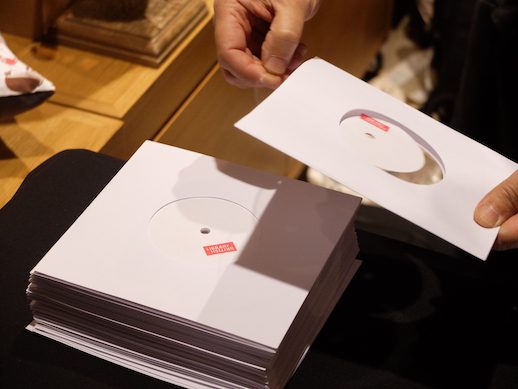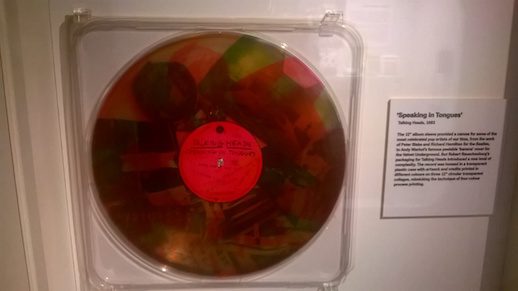Ian Preece visits Listen: 140 Years of Recorded Sound, an exhibition currently on show at the British Library:
140 Years of Recorded Sound sounds a somewhat overwhelming notion for an exhibition, but it turns out the British Library’s new initiative to highlight the preservation of their sound archive is a tightly structured affair. It’s a fascinating, curious 10” EP on clear vinyl – rather than the blockbuster magnum opus/quadruple concept album the V&A might stage. Or at least that’s the initial impression: an interesting display with a few curios of cool vinyl and snippets of sound and film, rather than the full works. And it is free. But then, when you think about it – and you find yourself spending longer and longer (OK, just another two minutes while I catch the mating call of a haddock from 1967) in one of the sound booths – sound doesn’t really need all that much space. The space is actually in your head, and that is infinite.
The British Institute of Recorded Sound started assembling recordings of steam trains, industrial machinery, folk songs, church bells, bird songs, all kinds of music and far-flung ethnographic documentation in 1955. In 1983 the archive came under the auspices of the British Library. Today the library is in a race against time to digitise over a million discs, hundreds of thousands of series of recordings, before increasingly obsolete technology crumbles to dust. At the launch event I should have got hold of one of the organisers and just asked for reassurance on the digital future: why that actually guarantees any more permanence than twentieth-century hardware. (It wasn’t any inherent technical fault that meant all those editions of The Likely Lads got wiped.) Especially as, in the foyer, Aleks Kowlkowski was doing a brisk trade in cutting beautiful clear-lacquer 7” singles of people’s own voice recordings straight to disc using a fine-looking 1957 Cartavox recording machine with seemingly no hitch, no smoke coming out the back or any smell of burning solder. (My other regret: not bringing along some Dick Higgins poem or somesuch, to immortalise myself in wax.)
But formatting’s a quibble; it’s enough that someone cares sufficiently to preserve all this real life stuff in this day and age. And I love an exhibition where there are plenty of headphones, so no cause for unseemly jostling. If you work your way from left to right, ‘A-side’ to ‘B-side’, you start off with a 14-second loop of Ludvig Koch’s 1889 recording of his caged white-rumped shama, the world’s first wildlife recording, through a potted history of the phonograph and the revolution brought about through portable tape recording. There’s Édourard-Léon Scott de Martinville’s entertainingly rough 1860 rendition of ‘Au Claire de la Lune’, alongside some fine hammy footage of Simon Dee instructing a Radio Caroline co-pirate on when to hit the start button on the turntable (even better is the clip of the pirate ‘technicians’ sitting around the ship’s canteen smoking fags, waiting for their tea, looking like a bunch of disgruntled trawlermen). The next monitor along, the alluring Delia Derbyshire is manipulating sinetones and white noise in the early sixties’ BBC Radiophonic Workshop. There’s Robert Rauschenberg’s beautiful translucent 12” plastic-case packaging of Talking Heads’ Speaking in Tongues, before a panel featuring a wall mounting of the ‘first’ dub single, the Hippie Boys’ ‘Voo-Doo’, their 1971 B-side to Little Roy’s ‘Hard Fighter’. I think you could mount an exhibition solely dedicated to the ‘first’ dub album. Perhaps even more controversially the British Library have gone for Keith Hudson’s Pick a Dub from 1974 as ‘one of the earliest . . . possibly the first to be conceived of as such’ dub albums – I’m pretty sure that at least Java Java Java, Aquarius Dub, Lee Perry’s Blackboard Jungle and Joe Gibbs’ Dub Serial all pre-date Hudson’s masterpiece by a year or so. Still, the organ on ‘Voo-Doo’ is terrific.
There’s an eye-catching assortment of picture discs in some of the glass cabinets – including a finely coloured set of minute translucent flexi-disc postage stamps from Bhutan in 1972, an impressively large ghetto-blaster complete with a cassette of LL Cool J’s Radio that made me feel very old, and a super-rare copy of Patti Smith’s bootleg live lp Good Friday, part of the British Phonographic Institute’s anti-piracy stash that was donated to the British Library.
Martin Ware, formerly of the Human League and Heaven 17, and now Visiting Professor of Sound at places like Queen Mary College and the Royal College of Art, was looking good in his blue leather car coat and black turtle neck as he formally opened the exhibition. He spoke of the deep bass hum from the steel forges throbbing down the valley into the Sheffield of his childhood, and of how, at the end of the day, all music and sound circles back to emotion, and speaks to a sense of the future, and to outsiderdom.
I wolfed down a couple of the fine veggie burger canapés and a beer, then retreated to the sound booths, where you can metaphorically spin the dial through a hundred different sound sources: one minute a world-weary John Peel would rather be outside in the sunshine in the park than stuck in the studio playing Pink Floyd’s ‘The Massed Gadgets of Hercules’; the next you can tune into Jorge Luis Borges enthusing over Don Quixote at the ICA in 1971. If it’s too noisy to quite catch Tony Benn live on stage with Test Department, or Chris Watson’s recording of vultures tearing apart a zebra, then there’s always Oval’s ‘The Politics of Digital Audio’ from 1994 or Annette Peacock and Paul Bley’s 1971 Moog freak-out ‘I’m the One’. As I found myself engrossed in another snippet, speculating upon who would have stayed tuned into Paul Hollingdale’s Breakfast Special on Radio 2 as the signal split and Radio 1 was birthed with Tony Blackburn at the mic exactly fifty years ago last month, I realised it was probably time to let someone else have a go. There are four booths though. And, as I overheard another launch party-goer say to his companion: ‘If you’re having a shit day at work you can just come in here and listen to whales.’ The exhibition runs until March. There’s no entry fee, but there is a donation box to help fund the Save Our Sounds programme; well worth the price of a Fopp CD on a wet lunchtime this winter, I’d’ve thought.
*
Find the exhibition details here.
Ian Preece on Caught by the River / on the radio (Third Light Home October edition)





